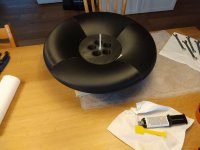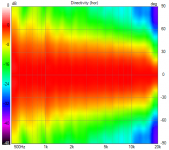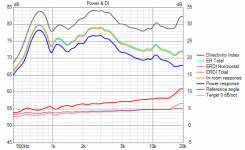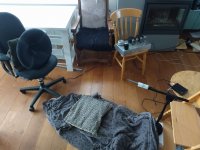Thanks! Got it, so basically just monitor the curve and adjust until it fits.
Basic ST260 works quite fine already (in reality), but thought to try find better fit for the driver. Now that the parameters of this great waveguide are available there is good benchmark to compare against.
Basic ST260 works quite fine already (in reality), but thought to try find better fit for the driver. Now that the parameters of this great waveguide are available there is good benchmark to compare against.
Yes, because you want a one single curve all the way through - one smooth curvature progression. No extensions with abruptly changing curvatures.Got it, so basically just monitor the curve and adjust until it fits.
I am VERY interested in the accompanying text explaining the importance of the curvature and how the OS minimizes it.BTW, this is the curvature of the ST260 R-OSSE version, curvature [mm^-1] along the curve -
View attachment 1123493
I've done my homework, but just don't get it...
I have attached an LE Script I have here that should serve as a basic example. You need to get the nodes, driver groups and element names set but it should show you the basic layout. The ABEC help is quite good, the Filter examples page is useful and the rest under Lumped element scripts should help with organizing the structure. It is much the same as AKABAK just without the point and click.Hi fluid,
thanks for the hint. Looked around in the Abec examples....tons of variations but not directly what I need. Could you or someone please just give me a example of a 24db/oct LR high or lowpass for a driver group? I know is maybe a too simple issue for asking here but I struggle with it as in any example there are many other things implemented, too. So I cannot directly see what is the simple part I need.
Thank you! 🙂
Attachments
I can only split it into two parts - 1) "the importance of the curvature" and 2) "how the OS minimizes it".I am VERY interested in the accompanying text explaining the importance of the curvature and how the OS minimizes it.
I've done my homework, but just don't get it...
1) The importance of smooth curvature comes from experience, it's purely empiric on my part.
2) I have no clue, I don't know what it would even mean, how it would be defined.
Obvisouly, for any practical horn we need the curvature to rise towards the termination, otherwise the device would either terminate abruptly or never. I can only say that this rise needs to be gradual (as shown) -
Here the idea is to connect a decreasing curvature near the throat (that's the OS feature) to an increasing curvature towards the mouth with something smooth enough.
Perhaps someone could try to construct a waveguide the other way around - first draw a curvature curve (a free smooth spline?) and then calculate the corresponding profile curve. Although I'm not sure it would help to come up with something noticeably better than what we already have. There's already very little left for improvement 🙂
Hi,
is the ST260 stl files on mabat site are the new R-OSSE version of the pdf ?
Has anyone printed a 1.4 throat mabat's horn, with mouth large enough for a 600 hz to 800 hz cut-off?
what is puzzling me is to use the ST260 for a 1000/1200 cut-off with a 1" but use the 12" driver below climbing that high, whatever it is an often seen approach.
is the ST260 stl files on mabat site are the new R-OSSE version of the pdf ?
Has anyone printed a 1.4 throat mabat's horn, with mouth large enough for a 600 hz to 800 hz cut-off?
what is puzzling me is to use the ST260 for a 1000/1200 cut-off with a 1" but use the 12" driver below climbing that high, whatever it is an often seen approach.
No, nothing has changed on the website (there's no reason).is the ST260 stl files on mabat site are the new R-OSSE version of the pdf ?
Mouth size itself has nothing to do with a "cut-off" - see (e.g.) page 14: http://www.at-horns.eu/release/R-OSSE Waveguide rev7.pdf#page=14Has anyone printed a 1.4 throat mabat's horn, with mouth large enough for a 600 hz to 800 hz cut-off?
Appears like a success to me 🙂Another Ath horn is born:
Maybe a stupid question... Would it be possible to use this tool "inverted" to make phase plugs with it?
My bad (my basic english level) , was talking about 1.4" throat because I had in mind the use of a 1.4" CD (because of the bigger diagphragme) that is more confortable with cut-off lower than 1000/1200 hz... hence the thought of a bigger throat on the horn to match the output size of the CD.
With these waveguides I don't see size as critical, due to their gradual and monotonic DI - something like what Tom showed should work wonders here, with plenty of options and freedom. With the larger throats I'd be more concerned about high frequencies - it will beam sooner than a 1" and that should (IMO) be reflected in the overall DI desing, allowing for its smooth and gradual rise. What's possible with a 1" simply doesn't work very well with 1.4" or larger (that doesn't mean it must be worse - you gain somewhere else, as usual).
Last edited:
That's a very different task, I'm afraid, far from being just an "inverse".Would it be possible to use this tool "inverted" to make phase plugs with it?
BTW, I couldn't resist and put the Tom's numbers into the simulator. It's a very nice horn indeed.
Here are the results, together with a direct 1.4" version (all else equal).


Here are the results, together with a direct 1.4" version (all else equal).
Last edited:
- Home
- Loudspeakers
- Multi-Way
- Acoustic Horn Design – The Easy Way (Ath4)



